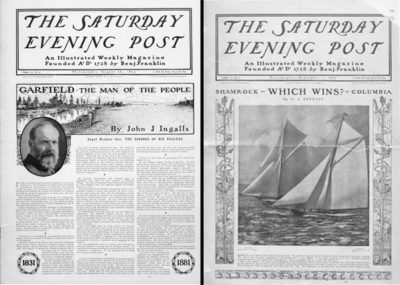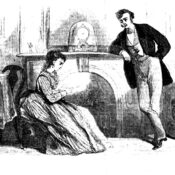No magazine is immortal. Even Life came to an end.
But The Saturday Evening Post keeps going. This year we will celebrate 189 years of publication—a remarkable survival in the magazine world. But even if we had been publishing for twice as long, we still wouldn’t have any advantage going into the future.
While we study ways to continue the Post into the future, we can’t help looking back wistfully to our Golden Era, when two men created a publishing empire.
One of the men was Cyrus Curtis, who purchased The Saturday Evening Post for $1,000 in 1897 (about $26,000 in 2009 dollars). It was not a lot of money, but then, the Post of that day was not much of a publication. “The magazine’s circulation was 1,600 copies. There was one-eighth of a column of advertising in its 16 pages without cover.
“Cyrus H. K. Curtis had bought the weekly for its name alone. His was the conception of a national weekly magazine to sell at five centers. The unanimous judgment of the trade was the weekly was a dying form, the price [an 1898 nickel equals $1.28 in today’s money] an economic absurdity.” (1)
George Horace Lorimer was the other great man. Under his editorship of 38 years, the Post‘s circulation grew from 1,600 to 3 million. (Circulation passed the 6 million mark in 1960.) In a 1937 editorial, the Post editors claimed Lorimer had “brought the Post from the status of an inferior country weekly to the greatest magazine on earth in prestige, circulation, and revenue.” (1)
Naturally, today’s Post‘s editors are interested in rediscovering Lorimer’s secret for growing readership.
Part of his success can be attributed to his ambition. In an early edition, Lorimer said of the Post, “It promises twice as much as any other magazine and it will try to give twice as much as it promises.”
According to Lorimer’s biographer:
“He worked day and night that first year, and in spite of a comparatively munificent salary—forty dollars a week—he was so poor that he often had no more dinner than the free lunch that went with a glass of beer in a saloon… At the office, in spite of the growing list of distinguished contributors, Lorimer sometimes virtually wrote an issue himself.” (2)
Another key to his success, according to a biographer, was Lorimer’s faith in his own vision.
“Lorimer knew exactly what he wanted to make of the Post. It was to be a magazine without class, clique or sectional editing, but intended for every adult in America’ seventy-five million population. He meant to edit it for the whole United States. Wesley Stout wrote later, “He set out to interpret America to itself, always readably, but constructively.” (2)
A 1953 history of the Post elaborated on this vision.
“[Lorimer had a] perception which knew what the reader wished to read before the reader knew it, an intuition which needed no questionnaires to guide it.
“The first necessity of a magazine is to be interesting; unless it is read eagerly, it is futile. But it was no mere magazine of entertainment that he edited… Entertainment attracts readers, but only character gets their respect and affection.” (3)
To give his magazine a broader American flavor, Lorimer developed a new, national tone—one that avoided the East-Coast flavor of most magazines.
“Lorimer perceived why American magazines were so much alike. The same authors rotated through the better publications. Editors and writers alike copied each other, sometimes quite shamelessly, and since most of the magazines were edited in New York, they had come to have a parochial point of view… Lorimer eliminated much of this difficulty at one stroke by refusing to look at another magazine.” (2)
Another Lorimer innovation was the higher graphic content of the Post. Starting in 1899, the Post reserved its covers for full-page illustrations. The first illustrated cover appeared on September 2, 1899, and showed the two great racing yachts, Columbia and Shamrock, as they were expected to look in the impending American Cup races.
Lorimer also aggressively pursued the best writers of the day.
“The Post revolutionized free-lance writing by giving decisions in 24 to 72 hours and paying on the first Tuesday following acceptance. Thus its free-lance contributors received their due in a week or so instead of a year, and sometimes were paid within as little as three days.
“Though it placed a heavy burden upon the editors, the new system got results instantly. Free-lance contributors over the nation and the world made a habit of turning first to the Post.” 3
Thus the Post offered works from highly popular writers like the still-remembered Bret Harte, Rudyard Kipling, Booth Tarkington, Joseph Conrad, and O. Henry, as well as the now-obscure Joel Chandler Harris, Richard Harding Davis, Rupert Hughes, Marie Corelli, Paul Laurence Dunbar, Opie Read, Joseph Lincoln, and Brand Whitlock.
“There was but one dish missing in the Post menu that Lorimer planned to serve his readers, and that was business fiction. To him business was a wonderful, romantic adventure. He could chronicle it in articles by and about businessmen, but he was certain that it could also be done in fiction.
“He had a strong feeling that this was the kind of writing which would give Post circulation an even faster upward swing. It had passed the 250,000 mark by the end of 1900, and no one doubted it would soon reach 500,000.
“Lorimer could not interest any writer in the business story. In vain he pointed out that ‘the struggle for existence is the loaf, lover or sex is the frosting in the cake,’ and that every business day was full of comedy, tragedy, farce, romance — all the ingredients of successful fiction. Business was a dominating factor in the lives of Americans, but the nation’s writers ignored it.” (2)
Lorimer’s fascination with the American businessman was in harmony with the national admiration for its wealth-builders and quick-witted entrepreneurs. Impatient to explore this new literary niche, Lorimer began writing an unsigned series of articles for the Post, entitled “Letters from a Self-Made Merchant to His Son.” They quickly built an enthusiastic following, and Post subscriptions jumped. The drama of business was, itself, good business.
In 1929, though, the romance of the American marketplace collided with reality. Through the months and years following the great stock market crash, the American public grew disenchanted with its corporate culture and melodramatic tales of boy-meets-business romances.
According to Otto Friedrich, a former Post editor, Lorimer never reconciled his vision of the American Dream to the realities outside his windows. He worked tirelessly, taking on more and more of the responsibility for managing the magazine—proofreading copy, writing ads, researching articles, and eventually becoming the chairman of the board at Curtis Publishing. In his world, American culture equaled American business, which could always be relied on to solve the nation’s ills and oppose new ideas and new people.
“It was perhaps this incredible involvement in his job, and not just his native conservatism, that made Lorimer become so remote from his readers and his people. An admirer of Hoover, he wrote to a friend, “I’ll fight this New Deal if it’s the last thing I do.” He called it “a discredited European ideology”; he railed against “undesirable and unassimilable aliens”; and the Post declared: “We might just as well say that the world failed as the American business leadership failed.” The election of 1936 was a humiliating blow, which, according to one chronicler, left Lorimer ‘crushed, bewildered, a stranger in a land he loved.'” (4)

Most of Lorimer’s principles—work, innovation, and better content—will still build readership. But given the state of our current economy, the unemployment rate, and the large number of Americans who worry, with good reason, about their job security, now may not be a good time to revive the genre of business fiction.
We could be wrong, though. Maybe the time has never been better for the Great American Business Novel.
This week, we include one of the business stories written by Sinclair Lewis for the Post. Lewis never shared Lorimer’s admiration of businessmen. In his novels Babbitt and Main Street, he wrote hilarious and deadly critiques of America’s commercialized culture. But Lewis never lost a deep-seated admiration for the men and women in American companies who made the country so prosperous and strong.
1 Au Revoir, But Not Good-By, The Saturday Evening Post, January 2, 1937
2 George Horace Lorimer and the Saturday Evening Post: The Biography of a Great Editor; John Tebbel, Doubleday and Company, Inc., 1948
3 A Short History of the Saturday Evening Post, Curtis Publishing Company, 1953
4 Decline and Fall: The Struggle for Power at a Great American Magazine; Otto Friedrich, Harper & Row, 1969
Become a Saturday Evening Post member and enjoy unlimited access. Subscribe now




Comments
Helped by the talents of Norman Rockwell and about a dozen of other illustrators , George Lorimer became a vision-maker of America. ” I want things to be middle-brow, middle income and middle of the road values, together these views became the pathway of this country. He created a link between baseball, funny stories and commericalism that shaped America through its greatest period of growth (1920 to 1960) from a world power to the world power. Errol D. Alexander, Arrowhead Institute
Elaine,
We passed this along to circulation. They should contact you within the next week.
-Thanks!
Wade Joseph Habshey
Web Design Associate
I just received my first issue of the SEP(jul/aug) and found duplicate pages 1 thru 12 and not 13 thru 24. which includes the JD Salinger fiction. How can I get a new issue, who. do I contact. thanks
Sam started up with just one store,
Then with a distribution plan
Began expanding more and more,
Becoming the world’s richest man.
He’d dropped a partner on the way,
A Captain Ahab was obscessed,
And followed Sam all night and day,
Not letting Sam get any rest.
At a stockholder’s meeting, Sam
Was attacked by Ahab’s trash talk.
Into the share holdings both swam,
Both drowning in a sea of stock.
Biz fiction – yes for the most part.
Based on Sam Walton of Walmart.
What an amazing recap of the history of the ‘Post.’ A circulation of six million is incredible! A publication still going strong after 189 years!
Long live ‘The Saturday Evening Post’! Congratulations to Dr. Cory and
Beurt SerVaas for helping make this happen during the past forty years!
I love it! One of the best articles yet that I have read concerning the history of ‘The Saturday Evening Post.’